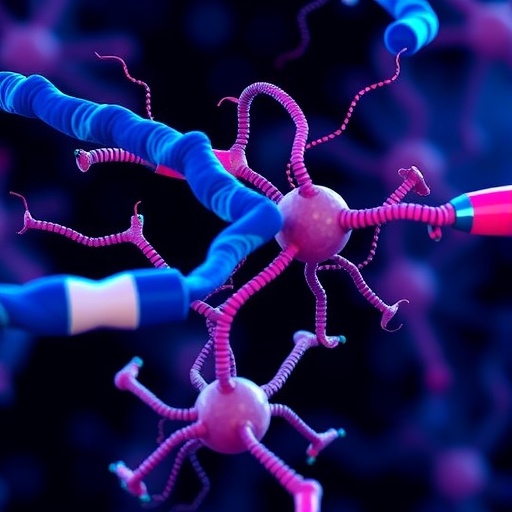In a groundbreaking study poised to redefine therapeutic approaches to fibrous dysplasia, researchers have identified protein kinase A (PKA) as a critical dependent factor and a promising therapeutic target in this complex bone disorder. The investigation, conducted using sophisticated mouse models that closely recapitulate the human condition, offers new hope for patients suffering from the debilitating skeletal anomalies characteristic of fibrous dysplasia. This development harnesses a molecular pathway long explored in various biological contexts but now, for the first time, elucidated as a key driver in fibrous dysplasia pathophysiology.
Fibrous dysplasia is a rare but severe skeletal disease marked by abnormal fibrous tissue replacing normal bone, leading to fragile, misshapen bones prone to fractures and pain. Its etiology has remained elusive, historically attributed to mutations in the GNAS gene that result in aberrant signaling cascades. However, therapeutic strategies have been limited to symptom management, lacking targeted interventions to halt or reverse disease progression. This study introduces a paradigm shift by pinpointing PKA as a molecular lynchpin, paving the way for novel mechanistically grounded treatments.
At the molecular level, PKA is a serine/threonine kinase regulated by cyclic AMP (cAMP), which modulates numerous cellular processes including metabolism, gene expression, and growth. Past research has established the centrality of cAMP-PKA signaling in cellular homeostasis and its dysregulation in various diseases, yet its specific involvement in fibrous dysplasia was not well defined. Through genetic and pharmacological manipulation in murine models, the researchers demonstrated that PKA activity directly influences the aberrant bone remodeling seen in fibrous dysplasia.
.adsslot_SK4NeOCFq9{ width:728px !important; height:90px !important; }
@media (max-width:1199px) { .adsslot_SK4NeOCFq9{ width:468px !important; height:60px !important; } }
@media (max-width:767px) { .adsslot_SK4NeOCFq9{ width:320px !important; height:50px !important; } }
ADVERTISEMENT
Intriguingly, the mouse models engineered to express constitutively active forms of PKA developed fibrous dysplasia-like bone lesions that closely mimic human pathology. Histological analyses revealed that excessive PKA signaling skews the differentiation of skeletal progenitor cells, favoring fibrogenic lineages over osteogenic lineages. This imbalance disrupts normal bone formation and mineralization, causing an accumulation of fibrous tissue. These findings illuminate a previously unrecognized mechanism whereby sustained PKA activation perpetuates skeletal deformities.
Moreover, the study employed a variety of cutting-edge techniques including in vivo imaging, transcriptomic profiling, and biochemical assays to dissect the PKA-driven pathways. Results indicated that PKA hyperactivation leads to the upregulation of key transcription factors and signaling molecules involved in fibrogenesis while downregulating those critical for osteoblast maturation. This dual modulation creates a cellular environment conducive to fibrous tissue expansion rather than healthy bone regeneration, offering a coherent explanation for the clinical manifestations of fibrous dysplasia.
The translational relevance of the study cannot be overstated. Fibrous dysplasia currently lacks curative treatment, afflicting thousands worldwide with chronic pain and disability. The ability to manipulate PKA activity pharmacologically introduces the possibility of disease-modifying therapies that could fundamentally alter patient outcomes. Such targeted approaches promise to reduce reliance on surgical interventions and symptomatic pain management, addressing the root cause at the molecular level.
This research represents a culmination of years of interdisciplinary collaboration, synthesizing advances in genetics, molecular biology, and bioengineering. The use of mouse models was crucial, enabling precise modeling of human fibrous dysplasia pathogenesis and providing a robust platform for therapeutic testing. The success of these models underscores the power of animal systems in unraveling complex human diseases and accelerating drug discovery.
The study also opens avenues for investigating PKA’s role in other fibrotic skeletal disorders, potentially broadening the impact of these findings. Given the versatility of the cAMP-PKA pathway across different tissues, it may be involved in a range of pathological conditions where fibrosis disrupts normal function. Future research will likely explore these contexts, guided by the foundational knowledge generated here.
Beyond therapeutic implications, the findings enhance fundamental understanding of skeletal biology, particularly the regulation of bone progenitor cell fate. The delineation of PKA as a molecular switch steering cell differentiation deepens our comprehension of bone homeostasis. This could have long-term effects on regenerative medicine and tissue engineering, informing strategies to promote healthy bone growth or repair.
Critically, the study also illustrates the complex interplay between genetic mutations and intracellular signaling networks in disease manifestation. While GNAS mutations set the stage, it is the downstream hyperactivation of PKA that executes pathological remodeling. This layered view refines our conceptual frameworks of genetic skeletal disorders, highlighting the necessity of targeting signaling transducers rather than solely genetic changes.
The therapeutic potential of PKA inhibitors, though promising, must be balanced against the enzyme’s ubiquitous roles in physiology. Careful design of selective agents that target pathological PKA activity without disrupting systemic functions will be essential. The mouse model outcomes provide proof-of-concept but translating these into safe human treatments will require extensive pharmacological optimization and clinical trials.
As the study gains traction, it is anticipated to stimulate a surge of research exploring combination therapies that modulate PKA alongside other signaling axes involved in fibrous dysplasia. Such integrative approaches might enhance efficacy and minimize adverse effects, tailoring treatments to the complex biology of each patient. Personalized medicine strategies could thus emerge, guided by biomarkers of PKA signaling status.
In summary, this landmark investigation redefines fibrous dysplasia from a poorly understood genetic disorder to a disease driven by aberrant PKA signaling, opening a therapeutic window that was previously unimagined. With its rigorous methodology and compelling data, the study promises to catalyze scientific and clinical momentum, ultimately improving lives of those burdened by this challenging skeletal disease.
The discovery that a ubiquitous kinase like PKA can play such a deterministic role in bone dysplasia illustrates the enduring value of basic biomedical research. It also confirms the axiom that elucidating fundamental molecular pathways remains the cornerstone of innovative therapy development. As science marches forward, such breakthroughs will continue to transform benchside discoveries into bedside remedies, fulfilling the promise of precision medicine for rare diseases.
Subject of Research:
Protein kinase A as a dependent factor and therapeutic target in mouse models of fibrous dysplasia
Article Title:
Protein kinase A is a dependent factor and therapeutic target in mouse models of fibrous dysplasia
Article References:
Liu, Z., Xing, L., Huang, W. et al. Protein kinase A is a dependent factor and therapeutic target in mouse models of fibrous dysplasia. Nat Commun 16, 5425 (2025). https://doi.org/10.1038/s41467-025-61402-z
Image Credits:
AI Generated
Tags: Abnormal Bone Tissue ReplacementAdvances in Osteopathic ResearchCyclic AMP Signaling in Bone CellsFibrous Dysplasia Treatment InnovationsGNAS Gene Mutations and Bone DisordersMechanistic Insights in Fibrous DysplasiaMolecular Pathways in Bone DiseasesNovel Therapies for Rare Skeletal DiseasesPKA and Bone HealthProtein Kinase A in Fibrous DysplasiaSkeletal Anomalies and Their TreatmentTherapeutic Targets for Bone Disorders





